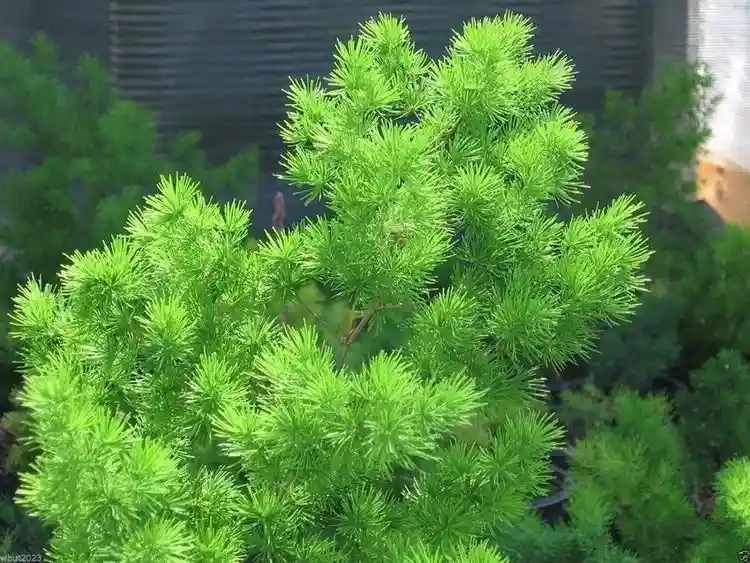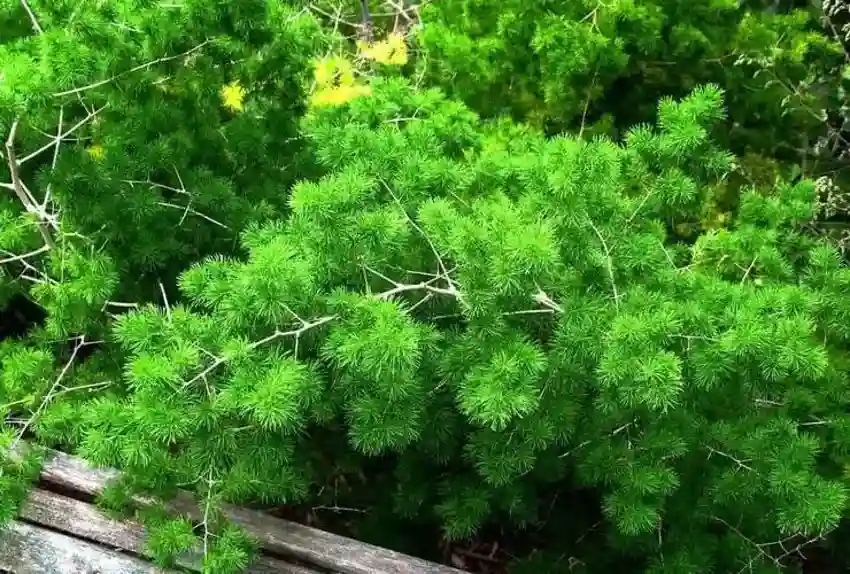The ming fern is an elegant and versatile plant cherished for its graceful form and resilience. With its cascading stems bearing soft, feathery foliage, the ming fern makes a striking addition to gardens, floral arrangements, and indoor spaces.
This fern imparts refined style with minimal fuss, needing little care to thrive. It brings rich texture and a fresh touch of green to its surroundings.
What Is a Ming Fern?
The ming fern belongs to the asparagus family and has the botanical names Asparagus macowanii and Asparagus retrofractus.
Despite its name, the ming fern is not a true fern. It falls under the broad lily family that encompasses over 3,000 diverse species including ornamentals, medicinals, and edibles.
Key Facts and Features
- Originating in arid regions of South Africa, the ming fern is an evergreen perennial with a high drought tolerance.
- This woody plant can reach heights of 4-6 feet tall and spread 3-5 feet wide. Its stems are stiff and grayish in color.
- Ming ferns are prized for their soft, fluffy clumps of foliage that resemble miniature pine trees. The “leaves” are actually cladodes that function like leaves.
- Tiny white or cream flowers bloom in spring and summer. If pollinated, they can produce small berries.
- Sharp spines along the stems can cause irritation, so gloves should be worn when handling the ming fern.
- With proper care, the ming fern can live 10 years or longer. One key to its longevity is allowing room for its tuberous roots to expand.
- In addition to its use in gardens, the ming fern is a favorite greenery for cut floral arrangements. Its cut branches remain fresh for up to 2 weeks.

Ming Fern Care and Growing Tips
When provided with the right conditions, the adaptable ming fern thrives with minimal care. Follow these tips for success in caring for your ming fern.
Sunlight
The ming fern grows well in light conditions ranging from partial sun to full shade. It can tolerate several hours of direct sunlight but does best with bright, indirect light.
Too much direct sun may cause foliage to yellow or brown. Filtered sunlight from a sheer curtain works perfectly for indoor ming ferns.
Water
Native to arid areas, the ming fern is drought-hardy once established. Water young plants regularly until their root system matures. Then allow the soil to partially dry out between waterings.
Indoors, provide weekly thorough watering. Misting a few times a week boosts humidity around the foliage. The key is well-drained soil that does not stay soggy.
Soil
For outdoor ming ferns, prepare a planting site with rich organic matter like compost. Amend clay-heavy native soil to improve drainage. The ideal soil pH is slightly acidic, around 6.0 to 6.5.
Use a commercial potting mix in containers. Combine peat moss, coarse sand, and compost for extra drainage. Repotting every 2-3 years replenishes nutrients.
Temperature and Humidity
Ming ferns thrive in warm temperatures from 60-80°F and moderate humidity around 50-60%. They can tolerate dips as low as 30°F. Indoors, use a humidifier nearby during winter months when heating systems dry the air.
Fertilizer
Apply diluted liquid fertilizer in spring as new growth appears. Slow release granular fertilizer worked into the soil provides a steady nutrient supply. Indoor plants may need extra feeding if foliage looks pale.
Pruning and Maintenance
Remove dead or damaged stems and foliage at any time to keep the ming fern looking its best. In early spring, trim off old cladophylls before new growth emerges. Dividing overgrown rootbound plants revitalizes them.
How to Propagate Ming Ferns
Ming ferns are easy to propagate by seed or division. For fuller, mature-looking new plants faster, choose division over starting from seed.
Propagating by Division
Dividing established root systems is the simplest propagation method. Carefully break apart the root ball with your hands or cut it with a sharp, clean knife. Replant divisions and water well.
Growing from Seeds
Collect berries when they are fully ripe and dark in color. Remove the pulp and sow seeds 1⁄4 inch deep. Keep evenly moist until germination, which takes 3 to 6 weeks. Transplant seedlings when they are a few inches tall.
Common Problems and Solutions
When provided with suitable growing conditions, healthy ming ferns have few issues. Monitor for these potential problems:
- Dry, shriveled foliage: Increase watering frequency. Move to a shadier spot outdoors.
- Leaf yellowing: Usually caused by overwatering. Allow soil to dry out more between waterings.
- Leaf browning/burn: Indicates too much sun. Move to a location with filtered light.
- Spotted leaves: Could be scale, mealybugs or spider mites. Wipe leaves down with insecticidal soap.
- Leggy growth: Needs more sunlight. Slow growth and small leaves show too little light.
- Failing to bloom: Natural in low light. Only affects appearance, not the plant’s health.
The Remarkable History and Origins of the Ming Fern
The ming fern boasts an illustrious history spanning centuries. Here are some intriguing details about this unique plant’s background.
Native to Southern Africa
Ming ferns originate from the Eastern Cape region of South Africa, where they thrive in warm, arid climates. Their native range experiences rainfall mainly in the summer.
The plants grow on rocky slopes and in the shelter of shrubbery. Their tuberous roots and drought tolerance equip them to handle periods of sparse rainfall.
Imported to Europe by Horticulturists
European horticulturists imported ming ferns to the continent’s botanical gardens in the 1870s. Their popularity as an ornamental plant took off soon after.
Resilient and easy to transport, ming ferns traveled well over long distances. Specimens arrived in pristine condition.
Named After a Victorian Plant Hunter
Ming ferns get their botanical name, Asparagus macowanii, from the Victorian plant collector who first introduced the species to Europe.
John MacOwan discovered the plant near the Umgazana River during an 1872 expedition in South Africa. He sent samples to London’s Royal Botanic Gardens at Kew.
Grown in Chinese Ming Pottery
The common name “ming fern” may come from the distinctive Ming Dynasty pottery in which the ferns were grown. Chinese gardeners mastered cultivating the plant as ornamental bonsai specimens.
The elegant ming fern nicely fit the refined aesthetics of Ming Dynasty art. Its delicate scale and texture paired well with the beautiful pots.
Best Uses for Ming Ferns in Gardens and Landscaping
Gardeners across hardiness zones 9-11 can incorporate ming ferns into beds, borders,containers, and shady or woodland gardens. Here are some ideal uses:
Accent Plantings
Situate ming ferns as specimens to draw attention and lend texture. Contrast the fern’s fine, lacy look with broad-leaved, bold foliage plants.
Borders Along Walks and Paths
The tiered, mounded form of ming ferns makes a perfect border. Leave them room to spread out and frame winding paths.
Mixed Borders and Beds
Blend ming ferns into beds and borders to add varied height, color, and texture. Combine them with ferns, grasses, flowering perennials, and shrubs.
Erosion Control
The ming fern’s extensive root system helps stabilize soil. Use them on slopes or banks susceptible to erosion.
Shade Gardens and Woodland Settings
With their love of filtered light, ming ferns naturally suit woodland gardens. Allow them to colonize and form drifts beneath trees.
Focal Points in Water Features
Situate ming ferns as focal points nearby water features. The fine texture pairs well with the sound and movement of water.
Container Plantings
Ming ferns excel in pots and planters. Select compact cultivars for small space gardening needs like patios, balconies, and entryways.
Integrating Ming Ferns Into Indoor Décor
Graceful ming ferns bring beauty indoors when temperatures drop outdoors. Use them as living works of art in these indoor spaces:
Entryways
Greet guests with a flourishing ming fern on an entry table or plant stand. The cascading stems make a flowing, welcoming statement.
Living Room
Place ming ferns atop shelves, side tables, and media cabinets to soften lines and add organic style.
Dining Room
A ming fern centerpiece lends an inviting touch over a dining table. The soft, airy texture stimulates appetite and conversation.
Home Office
Set a ming fern on your work desk or shelf to add life to your home office. Let it boost your focus and creativity.
Bathrooms
The high humidity of bathrooms suits ming ferns perfectly. Set one on a windowsill or tuck into a corner.
Bedrooms
Ming ferns help purify indoor air as you sleep. Put one on your nightstand for health benefits.
Floral Design Uses for Gorgeous Ming Fern Arrangements
With their long vase life, ming fern stems excel for cut arrangements. Their delicate form creates breathtaking bouquets and centerpieces.
Tall, Dramatic Centerpieces
Use ming fern branches as bold vertical elements reaching skyward in dramatic arrangements. Add curving stems for movement.
Whimsical Bouquet Filler
Tuck ming fern pieces into nooks and crannies of flower bouquets for irresistible whimsy and texture.
Cascading Effects
Let ming fern stems waterfall over the edges of vases and containers for rippling, cascading lines.
Table Centerpieces
Low, spreading ming ferns make perfect table runners down the center of long banquet tables. Sprinkle in flowers for pops of color.
Natural, Organic Texture
Ming ferns add breezy, effortless style and a natural look to arrangements of all kinds. Their texture enhances any flowers.
Artistic Garlands
Craft ming fern garlands to swag across mantles, over doorways, or surrounding mirrors and art. Accent with ribbons.
Enrich Your Life with Gorgeous and Graceful Ming Ferns
With their vibrant greens, cascading stems, and graceful style, it’s easy to see why ming ferns have been treasured for centuries. They require minimal care but make a huge impact with their beauty.
Add ming ferns to your garden, indoors spaces, or flower arrangements. They work wonderfully as an accent, border, container plant, or decorative cut foliage.
Native to arid areas yet equally happy in humid indoor conditions, the adaptable ming fern thrives with basic care. Its delicate texture and flowing form enhance any setting.
Mix ming ferns into your favorite plants and bask in their breezy elegance. You’ll enjoy their vibrance and add bright green life to your surroundings!













Comments are closed.